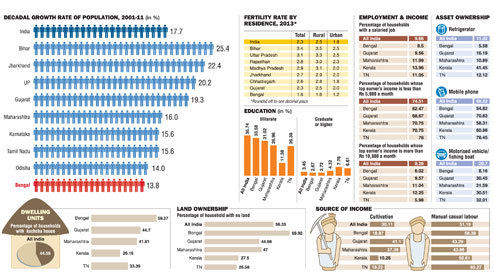
Data released by the Centre last month revealed that Bengal had one of the lowest population growth rates, 13.8 per cent, in the country for the 2001-11 decade. This is of a piece with the number thrown up earlier in 2013 for Bengal’s total fertility rate, which placed the state at the bottom of the table.
This development has taken place without being accompanied by the level of economic and social progress that has so far been seen to create conditions for low population growth.
Saswata Ghosh, economist and mathematical demographer at the Institute of Development Studies, Calcutta, said: “The basics in economics tell us that population growth rates tend to stabilise with rise in income and social well-being. We have seen such trends in the advanced economies of Europe around the 1960s and 1970s.”
Japan’s experience has been the same.
Bengal bucks that trend. The provisional socio-economic caste census (SECC) data of 2011 paints a dismal picture of rural Bengal: one-third of the population are illiterate and nearly three-fifths live in kuchcha houses and three-fifths earn their livelihood through manual labour. The breadwinner in 82 per cent of the households makes less than Rs 5,000 a month.
The situation of Odisha is somewhat similar. The state has witnessed a decadal population growth rate of 14 per cent but the socio-economic conditions of the rural population cannot be regarded as favourable for such a dip in the population growth rates.
“This is a demographic puzzle and I think it calls for more research,” said Anup Sinha, professor of economics at IIM Calcutta.
According to him, a proper social safety net can push down fertility rates – as it has been witnessed in various European countries – because people think that the government will take care of them in their old age. India is far from a situation like that.
Given the uncertainty about the future and the widespread misery, conventional wisdom expects the poor to have more children in the hope of augmenting future income. Besides, the lower probability of survival of all the kids also encourage the poor to procreate more.
But the finding from Bengal is different, as the total fertility rate has dipped. This rate is defined as the average number of children a woman would have over her reproductive life. Bengal’s fertility rate of 1.6 is not only below the national average but also lower than the replacement rate of 2.1 children per woman. This rate is taken to be 2.1 with the notion that a couple will be replaced by two children; 0.1 is added to factor in infertility among some women.
“The dip in the fertility rate in urban areas in Bengal is more to do with aspirations for their children, where parents are reducing fertility in search of social uplift. But in rural areas, the decline is distress-driven, as there are fears that the next child may starve to death,” said Ghosh, who has been tracking the trend for some time.
This sense of insecurity can be understood in the context of results from the census. Some 70 per cent of the rural households are landless, around 47 per cent of the rural population do not have primary education (national average of 50 per cent) and the percentage of graduates in the state is less than the national average and all the western and southern states.
The low decadal population growth might make Bengal’s current administrators happy as it means less strain on scarce public and private resources. As for the state’s poor social and economic scores, Mamata Banerjee can well blame her predecessor, the Left Front, as the survey related to the years to 2011, the year she took charge.
Several economists, however, said the trend of deprivation seen during Left rule doesn’t seem to have changed.
“Had there been a significant improvement in the situation after 2011, it would have been discernible to even non-expert eyes…. At least I haven’t seen any major changes in terms of job opportunities or education,” said Sinha.
Economists may wait for numbers, but till the next such survey results are out, Mamata can keep claiming that the Left destroyed both industry and agriculture, but the tables tucked in the voluminous report have several lessons for the chief minister.
Governments in Bengal have boasted about rapid industrialisation, never producing the numbers to support their claims. The provisional SECC data show that only 8.5 per cent of the rural population have salaried jobs -evidence of the lack of industrialisation. Agriculture offers a picture that is as gloomy: only 19 per cent of the rural population – against a national average of 30 per cent – earn their main livelihood from cultivation.
If more than 58 per cent of a state’s rural population earn their primary living through manual casual labour – which means they do not use skills and employment is irregular – there is little doubt that the state needs industrialisation for which availability of land is a precondition. But Mamata’s stated stand is against government acquisition of land.
“If the present government sticks to its stand on land, the next census will produce a more dismal picture of the state,” said an city-based economist who did not wish to be named.
Over the past few years, the Mamata government has been claiming that Bengal is ahead of the national average in terms of all the major indicators like the growth rate of the economy and the rate of growth in industry, agriculture and services.
“From a small base, one can achieve higher growth numbers. Besides, the national average includes other laggard states. So, clocking a higher than national average is no big deal. Instead of patting herself on the back for what she has achieved, she should take a lesson from these numbers and change her approach,” said the economist.
source: http://www.telegraphindia.com / The Telegraph, Calcutta,India / Front Page> Story / by Devadeep Purohit / Monday – September 07th, 2015